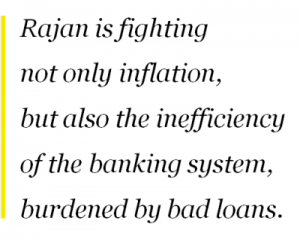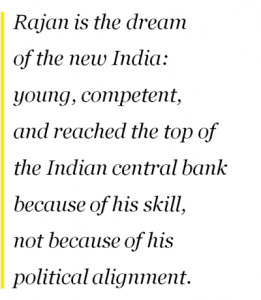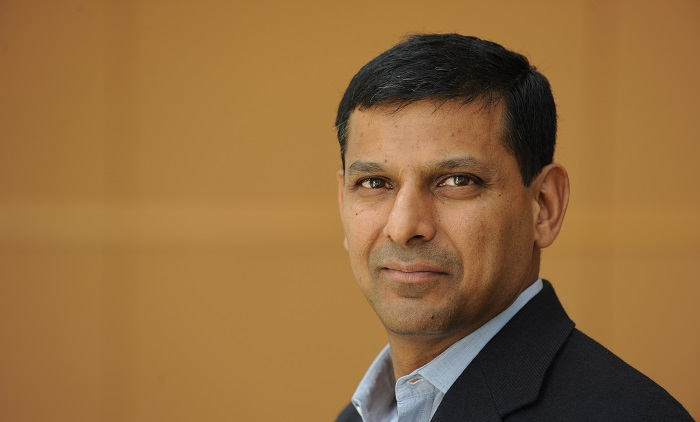The Governor of India’s Central Bank, Raghuram Rajan, is attacked for fighting the inefficiency of the banking system.
In any country in the world, a central banker who has managed to reduce inflation from 11 percent to 5 percent while simultaneously enabling an increase in growth from 5 percent to 8 percent in just three years would have a guaranteed reconfirmation. Not in India. The Governor of India’s Central Bank, Raghuram Rajan, much admired by the international press, is under heavy attack in his country.
I may be positively biased (Rajan has long been my colleague and co-author), but the charges against him are absurd. He is accused of being “mentally not fully Indian,” despite having been born and raised in India, and to date he has only an Indian passport. And for what reason? Because he worked in the United States for many years and holds an American Green Card. Rajan is also accused, due to belonging to the Group of 30, of being part of a “group set up to defend US’s dominant position in the global economy” and to serve the interests of international finance. He, who in 2005, in front of an enraged Alan Greenspan (then outgoing Chairman of the Federal Reserve), denounced the potentially destabilizing effects of financial derivatives.
To make matters worse, the person accusing him is Subramanian Swamy, PhD in Economics from Harvard, former minister of Commerce, and one of the leading architects of the economic liberalization India achieved in the early ‘90s. Swamy accuses him of raising interest rates too high, and, as a result, strangling small and medium enterprises and destroying agriculture.
 Why such anger? With his work, Rajan is fighting not only inflation, but also the inefficiency of the banking system, burdened by bad loans. The Indian banking system is mainly in public hands and was used to finance crony capitalism, which has held the country back for too many years. So far, Indian banks have lived in the illusion that all debtors would pay sooner or later, even when borrowers often borrowed from one bank to pay another.
Why such anger? With his work, Rajan is fighting not only inflation, but also the inefficiency of the banking system, burdened by bad loans. The Indian banking system is mainly in public hands and was used to finance crony capitalism, which has held the country back for too many years. So far, Indian banks have lived in the illusion that all debtors would pay sooner or later, even when borrowers often borrowed from one bank to pay another.
As Governor, Rajan has rightly decided to force the banks to cut down exposure to their most dubious borrowers, even at the cost of bringing out non-performing loans. From an economic point of view this is the best time. With the country growing at 8 percent, these losses can be easily absorbed by the banking system. If Rajan had done as most central bankers and closed his eyes to it, the problem would only have emerged at a time of economic crisis, when the “extend and pretend” mechanism (allowing an extension of credit and pretending that the debtor is solvent) becomes impossible. But in times of crisis, these losses are likely to bring down the banking system (see the Italian case) and then the whole economy is paralyzed. We have seen Japan, after the bubble of the late ‘80s, take nearly two decades to get rid of bad loans, and it’s still suffering the economic consequences of that crisis.
Though it was the right thing, this policy has produced collateral damage: banks’ share prices were affected, and even more affected were those Indian oligarchs who had enjoyed easy credit. They are the ones fueling dissent, because Rajan has dared to publicly criticize the behavior of some of them. In January, while at Davos, Rajan reprimanded Vijay Mallya, owner of the corrupt Kingfisher airline, who had sumptuously celebrated his 60th birthday despite his debt of 922 million euros to 17 banks. “If you are in [financial] trouble,” Rajan said, “you should be cutting down your expenses.” To ensure that there could be no doubt about his intentions, he added, “The system has been geared to favoring those who have the ability to work the courts. The policy that you [large businessmen] follow is that during good times you take the upside but in bad times you go to banks and ask how much of a haircut are you going to take.”
 Despite these attacks, public opinion is strongly on Rajan’s side. Until today, the reconfirmation of the head of the central bank head was a topic that interested only a few insiders, because the governorship had been entrusted to gray bureaucrats that left no impact. Rajan, however, is the dream of the new India: young, competent, and reached the top of the Indian central bank because of his skill, not because of his political alignment.
Despite these attacks, public opinion is strongly on Rajan’s side. Until today, the reconfirmation of the head of the central bank head was a topic that interested only a few insiders, because the governorship had been entrusted to gray bureaucrats that left no impact. Rajan, however, is the dream of the new India: young, competent, and reached the top of the Indian central bank because of his skill, not because of his political alignment.
As central banker he has not just talked about interest rates and inflation, but also dealt with corruption and education. It’s no coincidence a survey of readers of the leading Indian business newspaper reported that 87 percent would like to see him reconfirmed.
By late August, Indian Prime Minister Narendra Modi will have to decide whether to reconfirm him. This decision is the litmus test for change in India. On one hand is the young India, competent and meritocratic, that is conquering the world with its software and products, on the other hand is the India of the great political and economic dynasties, who established their power on political connections, if not directly on corruption, and that use a false sense of national identity to protect their declining power. It’s up to Modi to choose.
(Note: This post was originally published in Il Sole 24 Ore)






